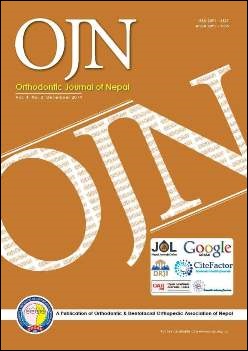Distribution of Malocclusion and Occlusal Traits among Tibetan Adolescents residing in Nepal
DOI:
https://doi.org/10.3126/ojn.v4i2.13895Keywords:
Adolescent, Angle classification, malocclusionAbstract
Introduction: Malocclusion is the irregularity of teeth and is considered as oral health problem. Though etiology of malocclusion is multifactorial, it has considerable impact on the self esteem and social adjustment of an individual.
Objective: To determine the prevalence of malocclusion and to assess the association between Angle classification of malocclusion and occlusal traits.
Materials & Method: A cross sectional study was conducted among 138 Tibetan students of grade 8-12 were selected. Students with history of orthodontic treatment were excluded from the study. Data was recorded and analyzed using SPSS 17.0 and chi square test was used to evaluate the association between Angle classification of malocclusion and occlusal traits.
Result: The prevalence of malocclusion was found to be Angle’s Class I (52.90%), Angle’s Class II (5.10%) and Angle’s Class III (9.40%). Occlusal traits such as overbite, increased overjet, openbite, crossbite, displacement and hypodontia was found to be 5.79%, 10.8%, 10.86%, 9.42%, 50,72% and 4.34% respectively.
Conclusion: The prevalence of malocclusion among Tibetan adolescent was found to be higher. Hence, oral health awareness, preventive procedures and promotional programs need to be more emphasized.
Downloads
Downloads
Published
How to Cite
Issue
Section
License
Copyright © held by Orthodontic & Dentofacial Orthopedic Association of Nepal
- Copyright on any research article is transferred in full to the Orthodontic & Dentofacial Orthopedic Association of Nepal upon publication in the journal. The copyright transfer includes the right to reproduce and distribute the article in any form of reproduction (printing, electronic media or any other form).
- Articles in the Orthodontic Journal of Nepal are Open Access articles published under the Creative Commons CC BY License (https://creativecommons.org/licenses/by/4.0/)
- This license permits use, distribution and reproduction in any medium, provided the original work is properly cited.




